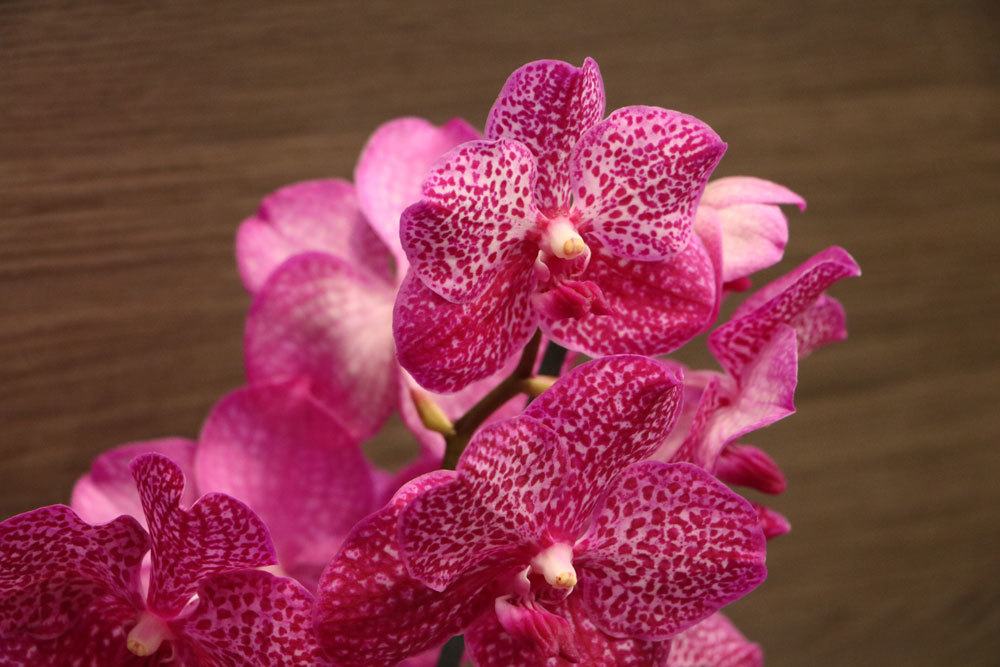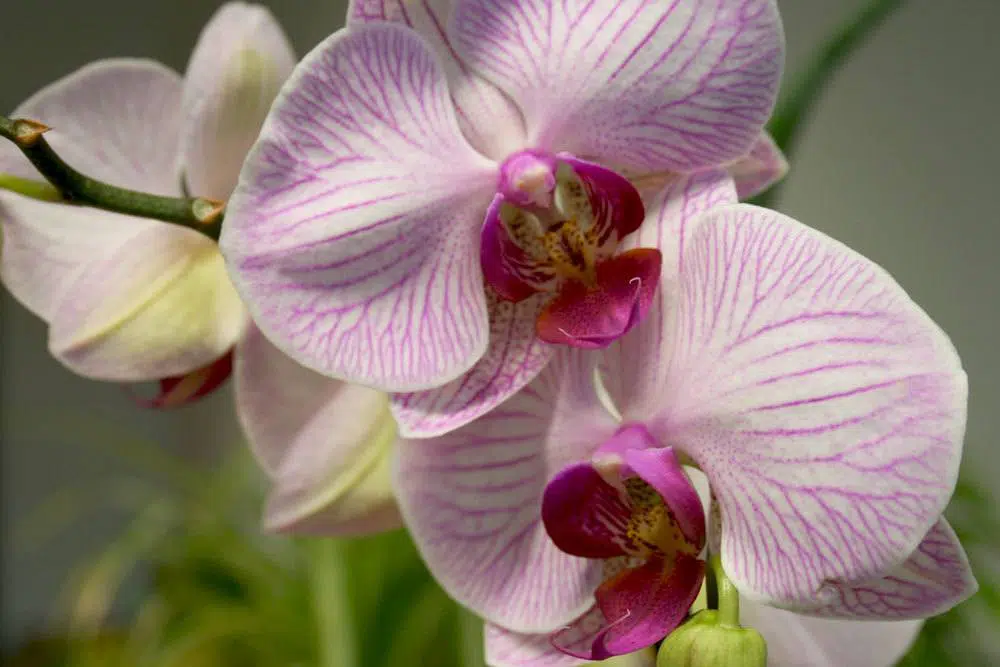Repotting orchids during flowering is generally not recommended, as it can disrupt the plant’s blooming cycle and cause stress to the orchid. However, there are specific situations in which repotting during flowering might be necessary or permissible:
- Emergency Situations: If an orchid’s current pot has become severely damaged, infested with pests, or has developed a mold or fungal issue, you may need to repot it, even if it’s in bloom. In such cases, repotting is essential to save the plant.
- Extremely Overcrowded Orchids: If your orchid has become extremely root-bound and the roots are tightly packed in the pot, restricting growth and causing health problems, repotting may be necessary for the long-term health of the plant. However, it’s best to aim for a time shortly after flowering.
- Hydroponic or Semi-Hydroponic Culture: Some orchid enthusiasts use hydroponic or semi-hydroponic culture, in which repotting is less disruptive because the roots are not buried in traditional potting mix. In these cases, repotting might be done during flowering if needed.
Contents
- 1 When you do decide to repot an orchid during flowering or any other time, follow these guidelines:
- 2 Repot orchid during the flowering period
- 3 Venus slipper (bot. Paphiopedilum)
- 4 Risky varieties
- 5 Repotting during flowering: instructions
- 6 prepare tools
- 7 remove the orchid from the pot
- 8 check roots
- 9 transplant the orchid
- 10 moisten the orchid
- 11 Author
When you do decide to repot an orchid during flowering or any other time, follow these guidelines:
- Choose a new pot that is just slightly larger than the current one to provide room for growth but avoid excessive space that can lead to overwatering.
- Use a well-draining orchid potting mix suitable for the specific type of orchid you’re growing.
- Be gentle when removing the orchid from its old pot. Try not to damage the roots or disturb the plant too much.
- Trim any dead or rotting roots and inspect the plant for signs of pests or disease.
- After repotting, water the orchid thoroughly and place it in a location with appropriate light conditions for its species.
- Understand that repotting during flowering may cause the plant to drop some or all of its blossoms, and it may take time for the orchid to recover and produce new flowers.
If your orchid is not in immediate distress and can wait, it’s generally best to repot after flowering when the plant has entered a growth phase and will be less stressed by the process. This allows the orchid to recover and establish itself in its new pot, ultimately leading to healthier and more robust blooming in the future.
Repot orchid during the flowering period
The question of whether orchids may be repotted during the flowering period is justified. These tropical plants have an extremely long flowering period, but it is not always obvious whether moving them to fresh substrate would harm the plant even more. However, a variety of reasons may arise during the flowering period why orchidaceae need to be repotted:
- Pest infestation
- Disease
- Fungal attack
- drought stress
- too little space in the tub
- strongly compacted substrate
- substrate is moldy
In these cases, you usually have no choice but to reach for a shovel, scissors and a new container to save your orchid plants. This is often necessary if your specimen blooms incessantly and does not seem to stop. This is often the case, for example, with the popular moth orchids (bot. Phalaenopsis), because they belong to the three genera within the orchid family that, as hybrids, present their pretty blooms throughout the year. The wild forms do not have this problem and bloom only from the fall season to spring, which would make the move much easier. The other genera, which also bloom all year round, are the following:
Venus slipper (bot. Paphiopedilum)

This is exactly where the biggest problem arises. It is not recommended in itself to repot orchids of any kind during the flowering period. After the move, the plants must first form new roots again, settle with them in the substrate and still support a flower at the same time. Since this is particularly draining after a disease or pest infestation, the move may even prove fatal to the plant. If it is possible and your specimen is at the end of the flowering period, you should wait a little longer and then move the plant to a new container. If that is not possible, the following first aid measures are recommended:
- Control pests
- fight pathogens
- fight fungi
- remove infested, visible plant parts
- Adapt care
In this way, you can sometimes get your orchid through to the end of the blooming season.
Risky varieties
But if, for example, the roots are infested or the orchid is already lifting out of its pot, you need to repot as early as possible. At the same time, expect your orchids to take much longer to recover afterwards. If you are unlucky, you may also experience complete death of the specimen. This is more common, especially with the following genera:
- Brassia
- Cattleya
- Cymbidium
- Dendrobium
- Masdevallia
- Miltonia
- Miltoniopsis
- Oncidium
- Phragmipedium
- Stanhopea
- Zygopetalum
Especially with these, it is not recommended to repot during the flowering season. Instead, if you keep the hybrids that bloom year-round, you have no choice but to repot them. Fortunately, these are often hardier than the other orchid genera and in most cases will survive repotting if care afterwards is appropriately good. If you must make the move to fresh substrate, it is recommended that you repot the year-round flowering genera in either spring or fall. At this time, they usually receive a growth spurt, which can have a positive effect on rooting. For the other orchids that have a defined blooming period, be sure to stick to it to avoid problems.
Note: There is a big difference when repotting native orchids, as in most cases they are not perching plants and thus survive the move to fresh substrate much better. For example, the helmet orchid (bot. Orchis militaris) is a bulbous geophyte that can be repotted or moved to another bed very easily thanks to its overstory organ.

Repotting during flowering: instructions
If you decide to repot one of your tropical orchids while it is in bloom, you will need to take extra care. Since the plants will have to exert a lot of effort afterwards to transplant root formation and rooting to the substrate, there are a few points you need to keep in mind. Repot at a rhythm of two to three years if the growth is good, because during this time the plants form enough plant material and take root strongly. You can tell if a specimen needs repotting when the substrate is heavily rooted and the plant is already halfway out of the pot. If the plant is repotted during flowering, you will need the following materials and utensils to do so:
- larger container
- substrate
- secateurs
- Spray bottle
Make sure that the container meets the requirements of the orchid. Some genera require light at the roots and so you should go for a translucent pot, such as moth orchids. Others you can simply place directly in a regular pot if the roots do not need fresh air or rely on light. Choose the substrate as well as the pot according to the requirements of the plant. Many tropical orchids want an extremely loose substrate to sit on rather than be buried in. If you are unsure of the substrate you need for your species, be sure to check before you buy. There is nothing wrong with purchasing high quality substrate. Once you have all the utensils there, follow these repotting instructions:
prepare tools
Start by cleaning your tools. Be sure to sharpen your pruning shears before using them, so you don’t tear at the roots and damage them. Likewise, you should disinfect or clean them to avoid possible infections from the cuts. Proceed in the same way with the spray bottle.
remove the orchid from the pot
Now take the orchid together with the pot in your hand and look at the roots and the substrate. If this is compacted, you should briefly check whether it is firmly seated in the pot. If so, moisten this a little to make it easier to remove from the pot. For this, take the spray bottle, as this will not wash away all the substrate at once, which could damage the roots. Carefully detach the plant from the pot and substrate at the point between the root ball and the leaf head. At this point, do not damage the delicate plant and the existing flower.
check roots
Once you have released the plant from the pot, carefully remove the excess substrate. Expose the roots as much as possible so you can inspect them closely. Remove any that are dried out, glazed, brown, mushy or broken. These will only negatively affect growth and would significantly affect the rehabilitation of the plant. However, be sure not to damage any healthy roots.
transplant the orchid
Fill the new pot with fresh substrate and carefully place the orchid in it. Depending on the species, you may need to place the orchid either in or on top of the substrate. Then, take the pot up and gently tap it on the table to let the substrate trickle into all the crevices. For orchids sitting on the substrate, this is done beforehand.
moisten the orchid
Last but not least, moisten the substrate with the spray bottle. Likewise, you can spray the leaves if the species allows it.
After repotting, you should empty the planter after each watering if a large amount of water has collected there. Orchidaceae are very sensitive to waterlogging, as the substrate can begin to mold, which can quickly spread to the plants. In the follow-up period after repotting, you should watch your orchid very closely. If the bloom suddenly diminishes, you will either have to water it more or add fertilizer to help it regain its strength. In this way, you will help it through the difficult period after the loss and the formation of new roots.
Note: If you keep a species that uses wood or stones for perching, you can, of course, completely abandon the pot, because they do not rely on loose substrate. This also applies to the species that hang freely in the air and always present their roots.


